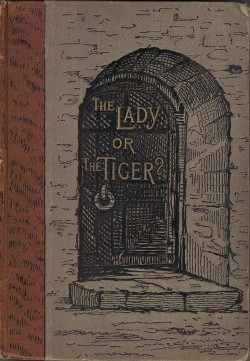This is how I remember high school
In the very olden time there lived a semi-horrifically boring teacher, whose ideas, though somewhat polished and sharpened by the progressiveness of distant teaching neighbors, were still large, florid, and untrammeled, as became the half of him which was horrifically boring. He was a man of exuberant fancy, and, withal, of an authority so irresistible that, at his will, he turned his varied fancies into facts. He was greatly given to self-communing, and, when he and himself agreed upon anything, the thing was done. That is how he convinced himself that his horrifically boring “Lady or the Tiger” lesson plans were awesome even though there was no lesson that involved critical thinking or even a “Lady or the Tiger” analysis.
When every member of his classroom and teaching systems moved smoothly in its appointed course, his nature was bland and genial; but, whenever there was a little hitch, and some of his students got out of their place by complaining about how boring his “Lady or the Tiger” lessons were, he was blander and more genial still, for nothing pleased him so much as to make the crooked straight and crush down uneven students who longed for more critical analysis and thought while reading.

Let’s start with a “Lady or the Tiger” summary.
A long time ago in a kingdom far, far away, a semi-barbaric king discovers his daughter is having an unlawful affair. The male suitor is arrested and forced to go to trial, a trial that consists of an arena with two doors. Behind one door is a tiger, set to maul the unlucky criminal; behind the other is a beautiful bride, set to euphemistically maul the lucky criminal.
The princess, who loves the young criminal, knows behind which door awaits the tiger, points to the right, indicating which door the young man should choose. The story ends.
Only the princess knows what or who mauls her forbidden lover.
Let’s continue with “The Lady or the Tiger” analysis and discussion.
If you think the hottie is behind the right door and you want “The Lady or the Tiger” teaching guide, click on this picture. The guide contains everything you see here, a week’s worth of lesson plans aligned to the common core, multiple graphic organizers (with answer keys), rubrics for easy grading, a copy of the story, and a quiz with an answer key.
Conflict. A person v. person conflict exists between the king and his daughter and the king and the young man. An individual v. society conflict exists between the two lovers and the rules of the kingdom. The central conflict in the story is an internal conflict within the princess as she struggles between watching her lover in the arms of another or watching her lover get devoured by a tiger. If the man chooses the tiger, I suppose you could classify it as man vs. nature, but we don’t know what’s behind that door. And we’re not really sure the arena could be classified as nature.
Theme. Stockton’s short story comments on the confusing nature of love and the subjective notion of civilization and barbarity. There is also an element of Determinism vs. Free Will and whether or not, if left to their own desires, humans make the right decision.

If you think the hottie is behind the left door and you want “The Lady or the Tiger” teaching guide, click on this picture. The guide contains everything you see here, a week’s worth of lesson plans aligned to the common core, multiple graphic organizers (with answer keys), rubrics for easy grading, a copy of the story, and a quiz with an answer key.
Irony. The ironic structure of the story-it has no end, for example-highlights the irony present in the story: (1) the princess and not the criminal is the story’s true loser; (2) the king, despite the outward appearance of sophistication is, at heart, a cruel semi-barbarian; (3) the princess deliberates for days on whether or not to save her lover
Point of View. Do not confuse the author with the narrator. The narrator is third person omniscient and knows the fate of the young man. The author does not.
Making Predictions in “The Lady or the Tiger” Lesson Plan
- RL. 9-10.1 Cite strong and thorough textual evidence to support analysis of what the text says explicitly as well as inferences drawn from the text.
- RL. 9-10.2 Determine a theme or central idea of a text and analyze in detail its development over the course of the text, including how it emerges and is shaped and refined by specific details; provide an objective summary of the text.
- RL. 9-10.3 Analyze how complex characters (e.g., those with multiple or conflicting motivations) develop over the course of a text, interact with other characters, and advance the plot or develop the theme.
This is where you would normally put the procedures.

It’s gonna take more than a 3-iron to fend off a tiger in the arena.
I’m not normal. Just look at the handout (Making-Predictions-Chart). Make copies. Read the story. Hand it out. If you’re not sure exactly what to do, just look at the answer key before school. Nobody needs to know.
If you like it, check out “The Lady or the Tiger” Teaching Guide. It’s got tons of teacher-friendly, student-friendly, ready-to-use lesson plans, handouts, and more. Or check out Short Story Teaching Guide Central for teaching other short stories.
You should probably grade it.
As far as assessing this particular “Lady or the Tiger” lesson plan, I’d go formative. It’s a fun speculation exercise that requires analysis and citing evidence. You can choose to assign either a literary analysis essay or a narrative essay as a summative assignment. I even have a rubric for each in the aforementioned “The Lady or the Tiger” Teaching Guide.
Share This: